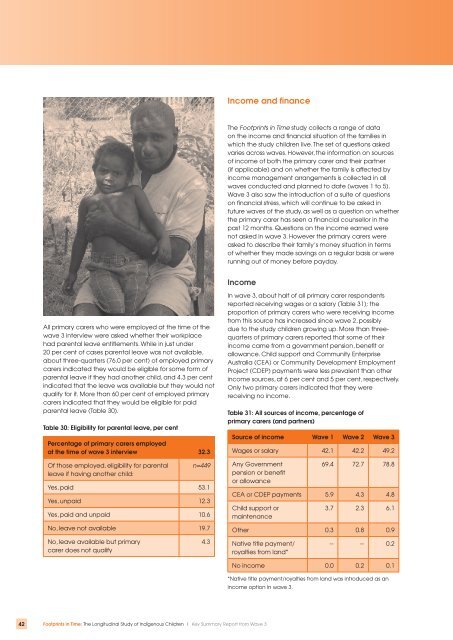Summary Report - pdf - Department of Families, Housing ...
Summary Report - pdf - Department of Families, Housing ...
Summary Report - pdf - Department of Families, Housing ...
Create successful ePaper yourself
Turn your PDF publications into a flip-book with our unique Google optimized e-Paper software.
Income and financeThe Footprints in Time study collects a range <strong>of</strong> dataon the income and financial situation <strong>of</strong> the families inwhich the study children live. The set <strong>of</strong> questions askedvaries across waves. However, the information on sources<strong>of</strong> income <strong>of</strong> both the primary carer and their partner(if applicable) and on whether the family is affected byincome management arrangements is collected in allwaves conducted and planned to date (waves 1 to 5).Wave 3 also saw the introduction <strong>of</strong> a suite <strong>of</strong> questionson financial stress, which will continue to be asked infuture waves <strong>of</strong> the study, as well as a question on whetherthe primary carer has seen a financial counsellor in thepast 12 months. Questions on the income earned werenot asked in wave 3. However the primary carers wereasked to describe their family’s money situation in terms<strong>of</strong> whether they made savings on a regular basis or wererunning out <strong>of</strong> money before payday.IncomeAll primary carers who were employed at the time <strong>of</strong> thewave 3 interview were asked whether their workplacehad parental leave entitlements. While in just under20 per cent <strong>of</strong> cases parental leave was not available,about three-quarters (76.0 per cent) <strong>of</strong> employed primarycarers indicated they would be eligible for some form <strong>of</strong>parental leave if they had another child, and 4.3 per centindicated that the leave was available but they would notqualify for it. More than 60 per cent <strong>of</strong> employed primarycarers indicated that they would be eligible for paidparental leave (Table 30).Table 30: Eligibility for parental leave, per centPercentage <strong>of</strong> primary carers employedat the time <strong>of</strong> wave 3 interview 32.3Of those employed, eligibility for parentalleave if having another child:n=449Yes, paid 53.1Yes, unpaid 12.3Yes, paid and unpaid 10.6No, leave not available 19.7No, leave available but primarycarer does not qualify4.3In wave 3, about half <strong>of</strong> all primary carer respondentsreported receiving wages or a salary (Table 31); theproportion <strong>of</strong> primary carers who were receiving incomefrom this source has increased since wave 2, possiblydue to the study children growing up. More than threequarters<strong>of</strong> primary carers reported that some <strong>of</strong> theirincome came from a government pension, benefit orallowance. Child support and Community EnterpriseAustralia (CEA) or Community Development EmploymentProject (CDEP) payments were less prevalent than otherincome sources, at 6 per cent and 5 per cent, respectively.Only two primary carers indicated that they werereceiving no income.Table 31: All sources <strong>of</strong> income, percentage <strong>of</strong>primary carers (and partners)Source <strong>of</strong> income Wave 1 Wave 2 Wave 3Wages or salary 42.1 42.2 49.2Any Governmentpension or benefitor allowance69.4 72.7 78.8CEA or CDEP payments 5.9 4.3 4.8Child support ormaintenance3.7 2.3 6.1Other 0.3 0.8 0.9Native title payment/royalties from land*-- -- 0.2No income 0.0 0.2 0.1*Native title payment/royalties from land was introduced as anincome option in wave 3.42 Footprints in Time: The Longitudinal Study <strong>of</strong> Indigenous Children | Key <strong>Summary</strong> <strong>Report</strong> from Wave 3




![pdf [107kB] - Department of Families, Housing, Community Services](https://img.yumpu.com/51272499/1/190x245/pdf-107kb-department-of-families-housing-community-services.jpg?quality=85)










![Land Claim - pdf [278kB] - Department of Families, Housing ...](https://img.yumpu.com/47002639/1/184x260/land-claim-pdf-278kb-department-of-families-housing-.jpg?quality=85)

![Borroloola Land Claim - pdf [299kB] - Department of Families ...](https://img.yumpu.com/46103973/1/184x260/borroloola-land-claim-pdf-299kb-department-of-families-.jpg?quality=85)